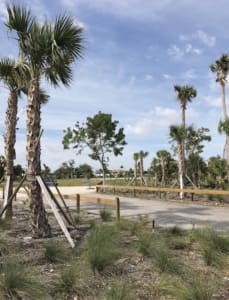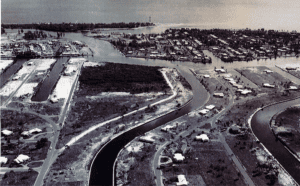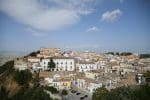Exchange Club Park is set to reopen
[vc_row][vc_column][vc_column_text]

By Marie Puleo
Since September 2015, Exchange Club Park, that rare piece of green space located on the Intracoastal Waterway in what many think is Lighthouse Point, but is actually Pompano Beach, has been inaccessible to the public from land or water while it has undergone a major transformation.
Stripped of its dense, towering Australian pines, which shaded the just over 14-acre area, the land was laid practically bare, and left with a big, flat, bald spot in the middle. The picnic tables, playground equipment, barbecue grills and volleyball area were removed.
This month, however, the park, tucked away at the end of Northeast 24th Street, is scheduled to reopen, featuring new landscaping, fencing and a walking path.
So why did the park undergo an extensive makeover? Because, technically, it really isn’t a park. The primary purpose of this land is to serve as a site for depositing materials dredged from the Intracoastal Waterway and the Hillsboro Inlet. It has been designated for that purpose since the 1930s.
“We have a hard time with folks understanding the difference between the two,” said Janet Zimmerman, Assistant Executive Director of the Florida Inland Navigation District (FIND), which owns the site.
FIND is responsible for the management and long-term maintenance of the section of the Intracoastal Waterway that stretches from the Georgia-Florida line down to Miami-Dade County. Since 1981, FIND has leased the property to the City of Pompano Beach for use as a public passive park operated in cooperation with the City of Lighthouse Point.
“It’s a nice arrangement that we can do dual purpose at this one site, but we need to make sure that it is available for its main purpose,” said Zimmerman.
The last time the property was used as a deposit site for dredged material was in the mid-1960s, when a pile of rock debris was dumped there, most likely from the dredging of the Hillsboro Inlet. A section of the Intracoastal is expected to be dredged sometime in 2018.
“That’s why we’ve been preparing this property,” said Zimmerman, underscoring an important distinction. From FIND’S point of view, they were not making over the park, but rather getting the property ready to receive dredged materials.
As part of this preparation, all of the non-native invasive plant and tree species within the property, including the Australian pines, were removed. The center of the property, which had several tree-covered mounds formed from past deposits of dredged materials, was cleared and leveled out to create a flat, open working area.
Although many people will miss the Australian pines, a species that was once widely used for erosion control along beaches, they are now legally prohibited for use in Florida due to their invasive nature, rapid growth rate and non-native status, according to the University of Florida’s Institute of Food and Agricultural Sciences (IFAS). The Australian pines are still on property, but in another form. They were turned into wood chips and used as mulch.
Other non-native invasive species removed from the property were the red-berried Brazilian pepper trees and mahoe trees (they posed a specific threat to the federally protected mangrove trees on the east edge of the property, along the shoreline), and ground cover like the mother-in-law’s tongue (its narrow, stiff yellow-tipped leaves grow vertically to about two feet tall). Everything native was left behind, including the mangroves, palm trees and some ficus.
The next phase of the project – the landscaping – lasted from August 2016 until this January (including a 90-day grow-in period). It involved the planting of a buffer of native trees, shrubs and ground cover around the perimeter of the property. This buffer includes a variety of palms, live oak, gumbo limbo, sea grape, pitch apple and buttonwood trees, as well as dune sunflowers. A new pine needle walking path was installed inside the buffer.
The flat open work area in the center of the property was seeded with native wildflowers that will provide natural habitat and ground cover to keep the soil in place, but due to an insufficient amount of rainfall, nothing has sprouted yet.
If the property is used as a deposit site for any upcoming dredging projects, this wildflower meadow will be covered with dredge material or equipment, and will need to be reseeded after each project.
One of the biggest attractions of the park has always been the sandy beach area along the Intracoastal. The beach will remain as it was before, where small boats, kayaks and paddle boards can come ashore.
Amenities such as new playground equipment and picnic tables won’t be placed in the park until more details about the 2018 dredging project are available.
For that project, FIND will be working with the U.S. Army Corps of Engineers to remove small shoals in the Intracoastal Waterway, from the Exchange Club Park area up to the North Broward County line. In this portion of the waterway, the authorized minimum depth is 10 feet, but the surveys that FIND conducts every few years show that in some areas shoals have reduced the depth to five or six feet. Because this stretch of the Intracoastal Waterway can be kept naturally deep for long periods of time, it could be another 10 to 20 years before it needs to be dredged again, though “it’s very difficult to predict,” said Zimmerman.
Despite all the preparations, there is a possibility that the Exchange Club Park site might not be needed for the upcoming project.
“It depends on the quality of the material that has to be dredged and the depth requirements and offloading ability of the equipment that is used to remove it,” said Zimmerman.
Once the material is dredged, beach compatible sand will be placed back either on the beach, just offshore or in the Hillsboro Inlet sand trap. This effort will be coordinated with a variety of government entities that are interested in obtaining the material for beach re-nourishment. The remaining material can be used as fill material in road construction and for other purposes.


THE HISTORY
FIND purchased MSA-726, which is the name FIND uses for the Exchange Club Park property (MSA stands for Material Spoil Area) as three separate parcels in 1936, 1942 and 1954 for the express purpose of using it as a long-range dredge material management area. Pompano Beach and Lighthouse Point initiated plans to use the MSA-726 as a passive park in 1980 to comply with Broward County’s recently established land use plan requirement to provide a minimum of three acres of park or open space for every 1,000 residents. The property enabled the two cities to claim seven acres each as open space.
Once the lease between Pompano Beach and FIND was signed in August 1981, the two cities leveled the land at the front entrance of the park. Lighthouse Point purchased playground equipment and $22,000 in fencing around the site, then Pompano supplied the labor to install the fence.While the cities agreed to share the development cost (about $100,000) and maintenance costs, the park became the pet project of the Pompano Beach Exchange Club, a service organization.
The club’s members soon went to work on cleaning the heavily wooded area. Then, they built a double-looped jogging path that meandered through the Australian pine trees. Because of the organization’s efforts, the cities adopted resolutions naming the park after the Exchange Club.
“We spent a lot of man hours over a period of several months cleaning out that property,” said James Wieland, a former member and past president (1979-80) of the Exchange Club who helped convert the land into a park.
Exchange Club Park opened in June 1982 and was formally dedicated on Sept. 11, 1982. The following year, the Exchange Club built a wooden gazebo at the top of a rock mound, and eventually, a path leading up to it. Their goal was to add something new each year.
The park is operated and maintained jointly between Pompano and Lighthouse Point. Presently, Lighthouse Point is responsible for opening and closing the park, daily housekeeping and the mowing of the park, while Pompano performs maintenance duties involving repairs. The Exchange Club conducts clean-up sessions several times a year, picking up garbage and large debris from the park and beach area.
As part of the recent revamping of the property, there had been plans to move the park’s entrance from the northeast corner of the park at 2800 NE 24th Street, to the northwest corner. An asphalt access road with parking spaces was to be constructed parallel to 24th Street within the park’s boundaries. Lighthouse Point city officials initiated the plan, which Pompano was in agreement with, in order to alleviate the severe parking problems that occurred during peak periods of park usage. The park’s gravel parking lot wasn’t large enough to hold all the cars, so people would park illegally on the grassy swale on the south side of 24th Street.
The parking lot project, which would have been funded by a $60,000 grant from FIND and matching funds of $30,000 each from both cities, had to be abandoned because the location where the new access road was to be constructed turned out to be wetland area. The two cities and FIND are still determining how to repurpose the funds that were allocated for the project. The gravel parking area has been reestablished in its original location. Various solutions to the parking problem along 24th Street are being considered.
“The area is not set up for large public gatherings,” said Lighthouse Point Public Works Director Charles Schramm, whose department oversees the daily maintenance of the park. “It’s in a small neighborhood with only one access street, and is more about small group and local resident usage.”
Pompano Beach, Lighthouse Point and the Broward Sheriff’s Office (BSO) have put together a ‘mutual aid agreement’ that will allow the Lighthouse Point Police Department to enforce state statutes as well as Pompano code within the park. Before the agreement was put in place, only the BSO was responsible for the security of the park. Some of the most common issues at the park have been the parking along 24th Street, noise, crowds, alcohol consumption, dogs (no dogs are allowed inside the park or on the beach area), campfires, fights and vehicles driving in areas of the park that are prohibited.
“I think the agreement will provide better coverage at the park because both police agencies will be monitoring the activity there,” said Lighthouse Point Police Chief Ross Licata. “We will be allowed to take enforcement action when we see violations occurring on the park property.”
FIND met with the BSO to make sure the new design of the property was in line with the BSO’s standards for good visibility into the park when driving by. The new design provides a more open viewing than what existed before.
Originally, the reopening of Exchange Club Park was expected to take place in May 2016, but preparing the property took longer than anticipated. The main reason for the delay was that when the project as a whole was put out to bid, only one contractor submitted a response, and it was significantly over the budget. It turned out to be more economical to break the project down into different parts, and use four different contractors for each type of work.
“The time it took go through the bidding and awarding process of each portion of the project added substantial time to the project,” said Zimmerman.
The process of obtaining a license from Broward County to remove the invasive mahoe trees within the mangrove area also added to the timeline.
The preparation of MSA-726 has cost FIND just over $1 million. FIND, a special State taxing district made up of 12 counties along Florida’s East Coast, gets its funding through a small portion of total real property taxes provided by these counties.
When FIND turned the property over to the City of Pompano Beach at the end of February of this year, final preparations for its reopening to the public got underway. The traditional chain link fence around the perimeter of the property was replaced with a decorative six-foot-high black aluminum “picket” fence, which was paid for by both FIND and the City of Pompano Beach; FIND contributed the amount it would have cost to put in a new chain link fence ($105,500), and Pompano paid the difference ($59,500).
“We’re excited about reopening and providing services for the residents around the park,” said Mark Beaudreau, Pompano Beach’s Recreation Programs Administrator. “It’s been a long, slow process, but we’re finally here. When the seasonal rains come and the meadow area grows in, I think it’s going to be an enhancement to the area. It will provide residents with a nice passive park.”
If the property needs to be used as a deposit site for the dredging operations that are planned for 2018, the park will be closed again for a short period of time. In the meantime, this summer is the perfect time for residents to get acquainted with the new incarnation of what for many has been a long-cherished, secluded waterfront spot.
[/vc_column_text][/vc_column][/vc_row]







